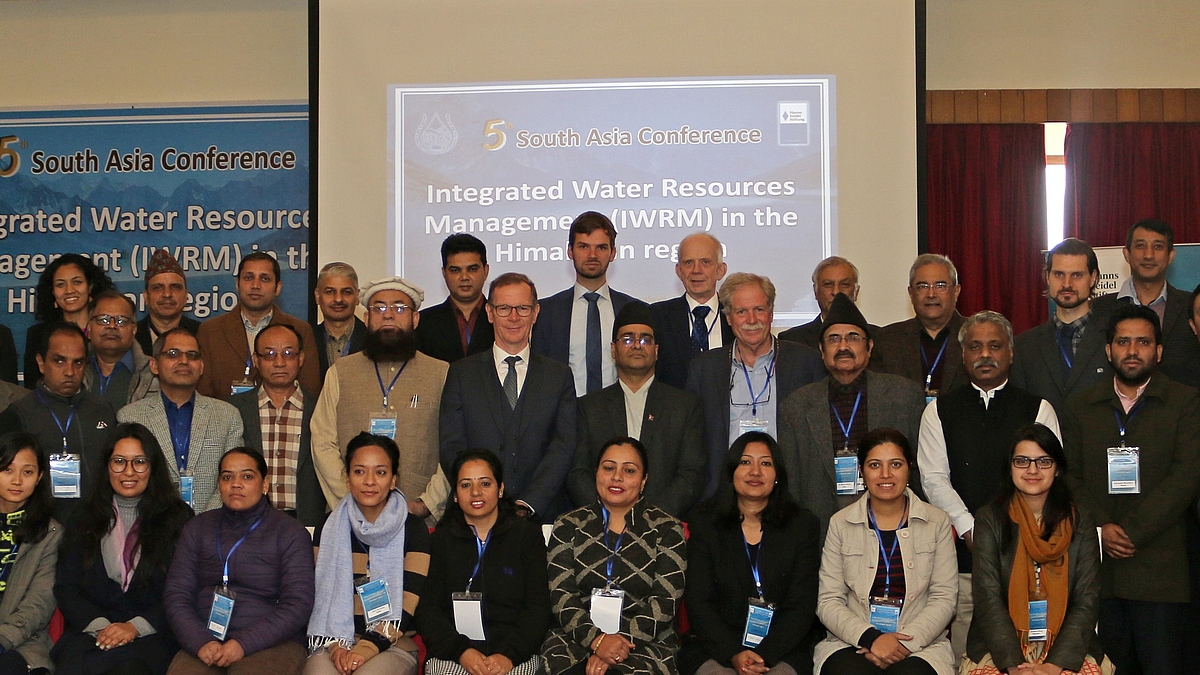Water Safety in the Himalayan Region
Integrated Water Resources Management in the Himalayan Region

Nepal Water Conservation Foundation (NWCF) and Hanns-Seidel-Stiftung (HSS) jointly organised the 5th South Asia conference on the theme of “Integrated Water Resources Management in the Himalayan Region” from 6th to 8th December 2018 at the Hotel Himalaya in Kathmandu. This conference drew participation of academia, civil society, government and non-governmental organisations. In addition to the participants and experts from Nepal, the conference was joined by the experts from India, Pakistan, Bangladesh, Bhutan and Germany.
In the first two days, a total of six technical sessions were organised to discuss the major challenges and emerging opportunities in the Himalaya region with regard to the water resources management, local level initiatives to effect IWRM, joint collaboration for data collection and analysis, inland navigation and sedimentation. The last session facilitated European Union-South Asia dialogue on water resources to explore potential areas of cooperation. The keynote speaker of the first session, Mr. Dipak Gyawali, stated that hydropower and building dams are not the only way through which development happens. There is a need for a holistic developmental approach which includes environmental factors also. Impact of landslides and floods on the health of local people in rural areas is often ignored. One reason for this is the current federal structure which is highly urban focused, he claimed. For environmental concerns to be taken into account while charting out the developmental plan, Mr Gyawali said that hydrological data and monitoring of environmental flows are must.
The second session was on the local level initiatives in the Himalayan Region with regard to Integrated Water Resource Management (IWRM). Mr. Kesang Jamtsho from NECS, Bhutan and Mr Dorji from RSPN, Bhutan together made a presentation on the general environmental practices exercised in Bhutan. They stated that the impact of climate change is severe in Bhutan. Due to climate change, glacial lakes, which are a major source of irrigation in the summer, are decreasing at an alarming rate. The communities dependent on glaciers are more likely to be impacted by such changes. They cautioned that the outburst of glacial lakes as a result of the increase in temperature may prove to be devastating for the country.
The third session was in the area of joint collaboration of data generation and its use in scientific research. Mr. Muhammad Shakil Ahmed from CEGIS, Bangladesh stated that there are 57 transboundary rivers in the Ganga-Brahmaputra-Meghna river basin, which are subject to regular floods, droughts and cyclone every year. As far as the forecasting is concerned, he stated that Bangladesh Water Development Board uses data from Nepal and India. He requested Nepal and India to give more real time data in order to avoid flood disaster by making people alert.
In the fourth session Dr Uttam Kumar Sinha from NMML, India presented his view on inland navigation and its opportunities and challenges. He started by saying that in South Asia, rivers are becoming more valuable method of connecting due to its size and nature. He added that India wants to play the role of facilitator or partner in the economic gains and prosperity of South Asia. He further stated that there should be more dialogues in the field of navigation and data sharing. As far as providing security in the fields of navigation is concerned he said that there should be effective and efficient penetration from participating countries.
In the fifth session Brig. (Retd.) Fiaz Hussein Shah from NIDM, Pakistan presented his views on the issues of sedimentation in dams. He gave brief description about the sedimentation process and the forms of sediments in various dams of Pakistan. Talking about Indus River basin, he suggested that changes be made in the Indus Water Treaty (IWT) between India and Pakistan to effect climate proofing in the basin. He also underlined the importance of IWT in the peace building process in South Asia.
The sixth session was on the European Union-South Asia dialogue on water resource management and finding the areas of mutual collaboration. The keynote speaker was Professor Martin Grambow from the State Ministry of Environment and Consumer Protection (STMUV), Bavaria, Germany. He stated that for a mutual collaboration, complete understanding on the land use, water use, dam retention areas, rain water harvesting structures and hydrological, geological, geographic, topographic descriptions are needed. For this, the countries sharing the same river should work together. He stressed on the need of strict supervision of governing authorities regarding implementation of policies.
The last day saw a field visit by the delegates to Dhulkheli, a place next to Kathmandu valley, to see and experience the IWRM practices on the ground. In the text to follow, a more detailed description is given about the three-day proceedings of the conference.
Read the full report here: 5th South Asia Conference Report
